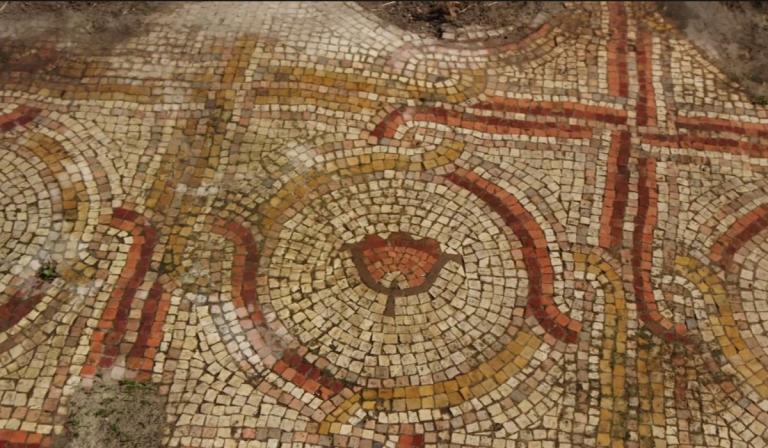
Israeli archaeologists have discovered the mosaic floor of an ancient church and are opening it up to the public in hopes that tourists and hikers will stop by the site. Archaeologists initially discovered the flower-designed mosaic floor in 1980, but it was soon covered with dirt, overgrowth and forgotten.
The Israel Antiquities Authority joined the Shoham Local Council, and a group of volunteers joined to “re-uncover it” and prepare it for the public, its first display in 40 years, according to a news release. The news release said it features “colorful floral designs.” The colorful mosaic, adorned with floral designs, is in the Shoham Industrial Zone. A Roman-period rural villa was located at the site, with agricultural processing installations and several additional buildings.
In the Byzantine period, a church was built on the site, on the ancient road that connected the coastal area with the Judean lowlands. The old road featured refreshing stations every few kilometers: Tel Tinshemet, Horvat El-Bira, and Horvat Hani, which offered travelers a place to rest and nourish.
“When we first came to the site, the mosaic was covered over with earth and weeds,” says Yair Amitzur, Director of the IAA Central Region Education Department. “Over the last month, we have been uncovering and cleaning up the site with the local community. Working surrounded by the blooming flowers of the region, one can imagine the artist of the floral mosaic being inspired by this view.”
“The site was first excavated in the 1980s by Professors Zeev Safrai and Shimon Dar,” says Anan Azab, IAA Director of the Central District. “It appears the site was settled in the Iron Age or earlier, possibly as early as the Chalcolithic period, and remained inhabited through the Islamic period.”
The restoration and cleanup project are being carried out by the Shoham community and by IAA volunteers from around the country as part of “Good Deeds Day.” The IAA and the Shoham Local Council also established a new seating area for hikers and residents. The IAA team connected the site with the adjacent new offices of the IAA Central Region in Shoham, dubbing it the “Israel Trail Angels.” Amitzur notes that “thanks to the project, Israel Trail hikers will be able to stop here, replenish their water supplies, drink a cup of coffee, and hear an explanation on the site.”
Eli Escusido, the director of the Israel Antiquities Authority, said, “It is very moving to meet good people who voluntarily enlist to enhance the local heritage and to create a good seating area along the Israel trail. This type of activity reflects the Israel experience at its best. I hope every hiker along the Israel National Trail will appreciate the humane values of our heritage and will perhaps be motivated to participate in one of the Israel Antiquities Authority initiatives and activities close to their home. The archaeological heritage can be found throughout the country; one only has to raise one’s eyes or perhaps look down on the ground to see it!”


